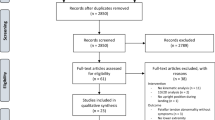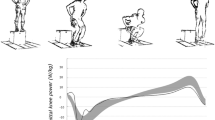Abstract
Purpose
This study was a cross-sectional study that aimed to compare the total Landing error scoring system (LESS) scores of individuals with Patellofemoral pain (PFP) with healthy controls and assess the association of pain, function, and psychological factors with LESS score.
Methods
Twenty-seven male athletes with PFP completed a standardized jump-landing task. They were compared with a matched, healthy group. Also, participants completed four questionnaires involving the visual analog scale (VAS), Anterior knee pain scale (AKPS), Tampa scale of kinesiophobia (TSK), Beck anxiety and depression inventory scale (BAI, BDI).
Results
PFP group had significantly a higher total LESS score than the control group. They displayed lateral trunk flexion and less knee flexion in the initial contact of landing. Our results showed a significant strong correlation between VAS, AKPS, and TSK with a final score LESS. In addition, a low to moderate significant correlation obtained between BAI, BDI and final score LESS.
Conclusions
The LESS is a useful clinical test for evaluating landing errors in people with PFP. Greater kinesiophobia, pain, poorer self-reported function and psychological factors were correlated with a total LESS score.
Similar content being viewed by others
Data availability
The datasets are not public available due to the confidentiality of the data, but are available from the corresponding author on reasonable request.
References
Hiemstra LA, Kerslake S, Irving C (2014) Anterior knee pain in the athlete. Clin Sports Med 33(3):437–459
Petersen W et al (2014) Patellofemoral pain syndrome. Knee Surg Sports Traumatol Arthrosc 22(10):2264–2274
Priore LB et al (2019) Influence of kinesiophobia and pain catastrophism on objective function in women with patellofemoral pain. Phys Ther Sport 35:116–121
Boling MC et al (2009) A prospective investigation of biomechanical risk factors for patellofemoral pain syndrome: the Joint Undertaking to Monitor and Prevent ACL Injury (JUMP-ACL) cohort. Am J Sports Med 37(11):2108–2116
Witvrouw E et al (2005) Clinical classification of patellofemoral pain syndrome: guidelines for non-operative treatment. Knee Surg Sports Traumatol Arthrosc 13(2):122–130
Padua DA et al (2011) Reliability of the landing error scoring system-real time, a clinical assessment tool of jump-landing biomechanics. J Sport Rehabil 20(2):145–156
Loudon JK et al (2002) Intrarater reliability of functional performance tests for subjects with patellofemoral pain syndrome. J Athl Train 37(3):256–261
Padua DA et al (2015) The landing error scoring system as a screening tool for an anterior cruciate ligament injury–prevention program in elite-youth soccer athletes. J Athl Train 50(6):589–595
Hanzlíková I, Hébert-Losier K (2020) Is the Landing Error Scoring System reliable and valid? A systematic review. Sports Health 12(2):181–188
Nunes GS, Barton CJ, Serrão FV (2019) Females with patellofemoral pain have impaired impact absorption during a single-legged drop vertical jump. Gait Posture 68:346–351
Willson JD, Davis IS (2009) Lower extremity strength and mechanics during jumping in women with patellofemoral pain. J Sport Rehabil 18(1):76–90
Briani RV et al (2022) Exacerbating patellofemoral pain alters trunk and lower limb coordination patterns and hip-knee mechanics. J Biomech 141:111215
Maclachlan LR et al (2017) The psychological features of patellofemoral pain: a systematic review. Br J Sports Med 51(9):732–742
Ferrari D et al (2018) Higher pain level and lower functional capacity are associated with the number of altered kinematics in women with patellofemoral pain. Gait Posture 60:268–272
Witvrouw E et al (2000) Open versus closed kinetic chain exercises for patellofemoral pain. Am J Sports Med 28(5):687–694
Cichanowski HR et al (2007) Hip strength in collegiate female athletes with patellofemoral pain. Med Sci Sports Exerc 39(8):1227
Herbst KA et al (2015) Hip strength is greater in athletes who subsequently develop patellofemoral pain. Am J Sports Med 43(11):2747–2752
Scott J, Huskisson E (1976) Graphic representation of pain. Pain 2(2):175–184
Negahban H, Pouretezad M, Yazdi M, Sohani S, Mazaheri M, Salavati M et al (2012) Persian translation and validation of the Kujala Patellofemoral Scale in patients with patellofemoral pain syndrome. Disabil Rehabil 34(26):2259–2263
Kaviani H, Mousavi AS (2008) Psychometric properties of the Persian version of Beck Anxiety Inventory (BAI). Tehran Univ Med J 66(2):136–140
Dadfar M, Kalibatseva Z (2016) Psychometric properties of the persian version of the short beck depression inventory with Iranian psychiatric outpatients. Scientifica (Cairo) 2016:8196463
Portney LG, Watkins MP (2009) Foundations of clinical research: applications to practice, vol 892. Pearson/Prentice Hall, Upper Saddle River
Rojhani Shirazi Z, Biabani Moghaddam M, Motealleh A (2014) Comparative evaluation of core muscle recruitment pattern in response to sudden external perturbations in patients with patellofemoral pain syndrome and healthy subjects. Arch Phys Med Rehab 95(7):1383–1389
Boling M, Padua D (2013) Relationship between hip strength and trunk, hip, and knee kinematics during a jump-landing task in individuals with patellofemoral pain. Int J Sports Phys Ther 8(5):661–669
Chu DA, Meyer GC (2013) Plyometrics. Human kinetics.
Willson JD, Davis IS (2008) Utility of the frontal plane projection angle in females with patellofemoral pain. J Orthop Sports Phys Ther 38(10):606–615
Dos Reis AC et al (2015) Kinematic and kinetic analysis of the single-leg triple hop test in women with and without patellofemoral pain. J Orthopaedic Sports Phys Ther 45(10):799–807
Paoloni M et al (2010) Kinematic and kinetic features of normal level walking in patellofemoral pain syndrome: more than a sagittal plane alteration. J Biomech 43(9):1794–1798
Glaviano NR, Saliba S (2018) Association of altered frontal plane kinematics and physical activity levels in females with patellofemoral pain. Gait Posture 65:86–88
de Oliveira Silva D et al (2019) Kinesiophobia, but not strength is associated with altered movement in women with patellofemoral pain. Gait Posture 68:1–5
Selhorst M et al (2020) Adolescent psychological beliefs, but not parent beliefs, associated with pain and function in adolescents with patellofemoral pain. Phys Ther Sport 45:155–160
Funding
This project was supported by a grant from the Ahvaz Jundishapur University of Medical Sciences for financial support (Grant number: PHT-9913).
Author information
Authors and Affiliations
Contributions
MS had the primary responsibility for writing the manuscript. FS and MS devised the project and its main conceptual ideas, devised the study design, MR collected data, and MJ analyzed the data. FS edited the final paper version. All authors have read and approved the final paper version of the manuscript and agree with the order of presentation of the authors.
Corresponding author
Ethics declarations
Conflict of interest
Authors report no conflicts of interest.
Ethical approval and informed consent
The present study was approved by Ethics Committee of Ahvaz Jundishapur University of Medical Science and was conducted in accordance with the World Medical Association Declaration of Helsinki. All participants signed informed consent before the entry of the study (Number: IR.AJUMS.REC.1399.374).
Additional information
Publisher's Note
Springer Nature remains neutral with regard to jurisdictional claims in published maps and institutional affiliations.
Rights and permissions
Springer Nature or its licensor (e.g. a society or other partner) holds exclusive rights to this article under a publishing agreement with the author(s) or other rightsholder(s); author self-archiving of the accepted manuscript version of this article is solely governed by the terms of such publishing agreement and applicable law.
About this article
Cite this article
Rabbani Havigh, M., Esfandiarpour, F., Saadat, M. et al. Jump-landing mechanics assessment using landing error scoring system in athletes with and without patellofemoral pain. Sport Sci Health 20, 97–102 (2024). https://doi.org/10.1007/s11332-023-01070-y
Received:
Accepted:
Published:
Issue Date:
DOI: https://doi.org/10.1007/s11332-023-01070-y




